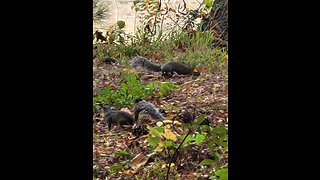Discovering Britain's Natural Treasures: A Wildlife Primer
Getting to Know British Wildlife: A Journey into the Natural Wonders of the UK
The United Kingdom is a land of diverse landscapes and ecosystems, offering a rich tapestry of wildlife that thrives in its woodlands, wetlands, coastlines, and urban environments. Exploring British wildlife allows you to connect with the natural world and discover the unique creatures that call this region home. Here is an overview of British wildlife and some tips for getting better acquainted with it:
Diverse Habitats:
Woodlands: The UK's woodlands are home to an abundance of wildlife, including native species like red squirrels, badgers, and a variety of woodland birds like the great spotted woodpecker.
Wetlands: Wetlands such as marshes and estuaries provide vital habitats for waterfowl like ducks, geese, and wading birds. You may also spot otters, water voles, and dragonflies.
Coastlines: Coastal areas host a variety of seabirds, seals, and seabound mammals. Watch for puffins, gannets, and seals basking on rocks.
Countryside: The British countryside is a patchwork of meadows, farmlands, and hedgerows where you can encounter hares, foxes, and a variety of birds such as skylarks and barn owls.
Urban Environments: Even in cities and towns, you can find urban wildlife, including foxes, hedgehogs, and a range of bird species like pigeons, sparrows, and urban-adapted gulls.
Tips for Exploring British Wildlife:
Visit Nature Reserves: The UK has a network of nature reserves managed by organizations like the RSPB (Royal Society for the Protection of Birds) and the Wildlife Trusts. These reserves offer excellent opportunities for birdwatching and wildlife observation.
Join a Local Wildlife Group: Many local wildlife and naturalist groups organize outings and events that provide opportunities to learn from experts and meet fellow wildlife enthusiasts.
Birdwatching: Invest in a pair of binoculars and a bird identification guide. Birdwatching is a popular and accessible way to connect with wildlife in your local area.
Wildlife Gardening: Create a wildlife-friendly garden by planting native flowers, providing water sources, and leaving wild areas for insects, birds, and other small creatures.
Record Your Sightings: Use smartphone apps or websites to record your wildlife sightings. Citizen science initiatives like the Big Butterfly Count and the RSPB's Big Garden Birdwatch help track species' populations.
Attend Nature Walks and Talks: Many nature reserves and organizations offer guided walks and talks on various aspects of local wildlife. These events can be both educational and enjoyable.
Respect and Protect: When observing wildlife, prioritize their welfare and minimize disturbance. Keep a safe distance, avoid loud noises, and never feed wild animals unless it's part of a conservation program.
By taking the time to explore and understand British wildlife, you can foster a deeper connection to the natural world and contribute to the conservation of these precious ecosystems. Whether you're a seasoned naturalist or a curious beginner, the UK's wildlife offers endless opportunities for discovery and wonder.
-
 2:30
2:30
"Chillearn: Elevate Your Mind, Embrace Tranquility"
1 year agoDiscovering Nature's Diversity: Eight New Species to Watch for in the UK in 2022
16 -
 1:03
1:03
RosePatch556
7 months agoNature's wildlife
354 -
 0:05
0:05
Chronic Pain Warriors
8 months agoDiscovering Nature's Golden Treasures.
10 -
 35:16
35:16
Transform Church
5 months agoIn The Wilderness / What's important to you?
2 -
 3:42
3:42
istaboca
1 year agoDiscover The Treasures Of Australia
4 -
 2:10:09
2:10:09
Oportuno Podcast
4 months ago042 - Botanical Treasures
12 -
 0:32
0:32
Rumble23
9 months agoDiscovering New England's Timeless Treasures: Iconic Historic Sites
6 -
 8:47
8:47
AV
4 months ago#732 Opportunity - Worcestershire Local Nature Recovery Strategy
2 -
 12:08
12:08
A Frugal Homestead
2 years ago $0.01 earnedTREASURE HUNTING - Victorian Edwardian Peiriod Treasure
62 -
![Looking around the lake in the botanical garden, where nature reigns [Nature & Animals]](https://hugh.cdn.rumble.cloud/s/s8/6/U/6/U/I/U6UIc.0kob.1.jpg) 0:16
0:16
Nature & Animals
2 years agoLooking around the lake in the botanical garden, where nature reigns [Nature & Animals]